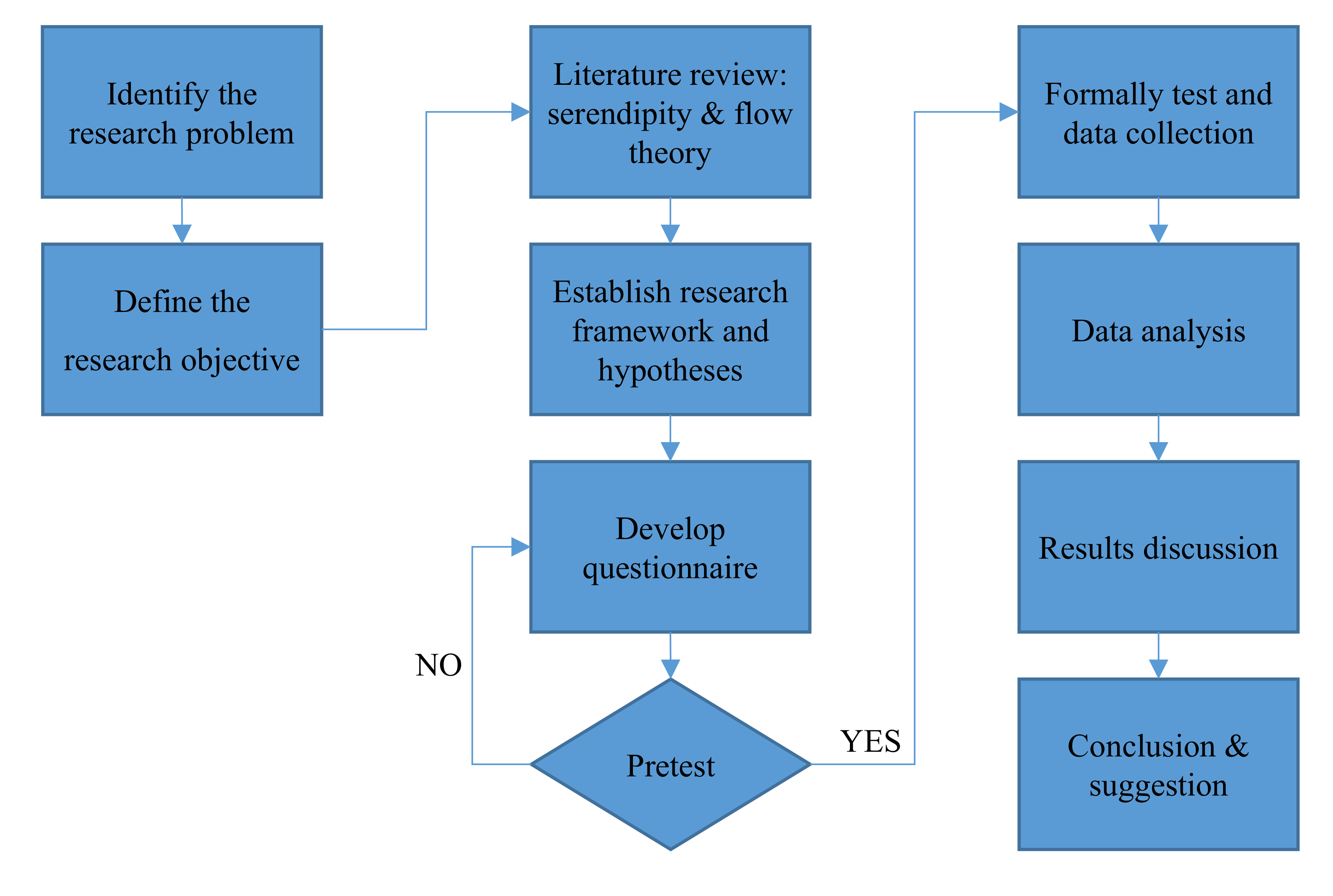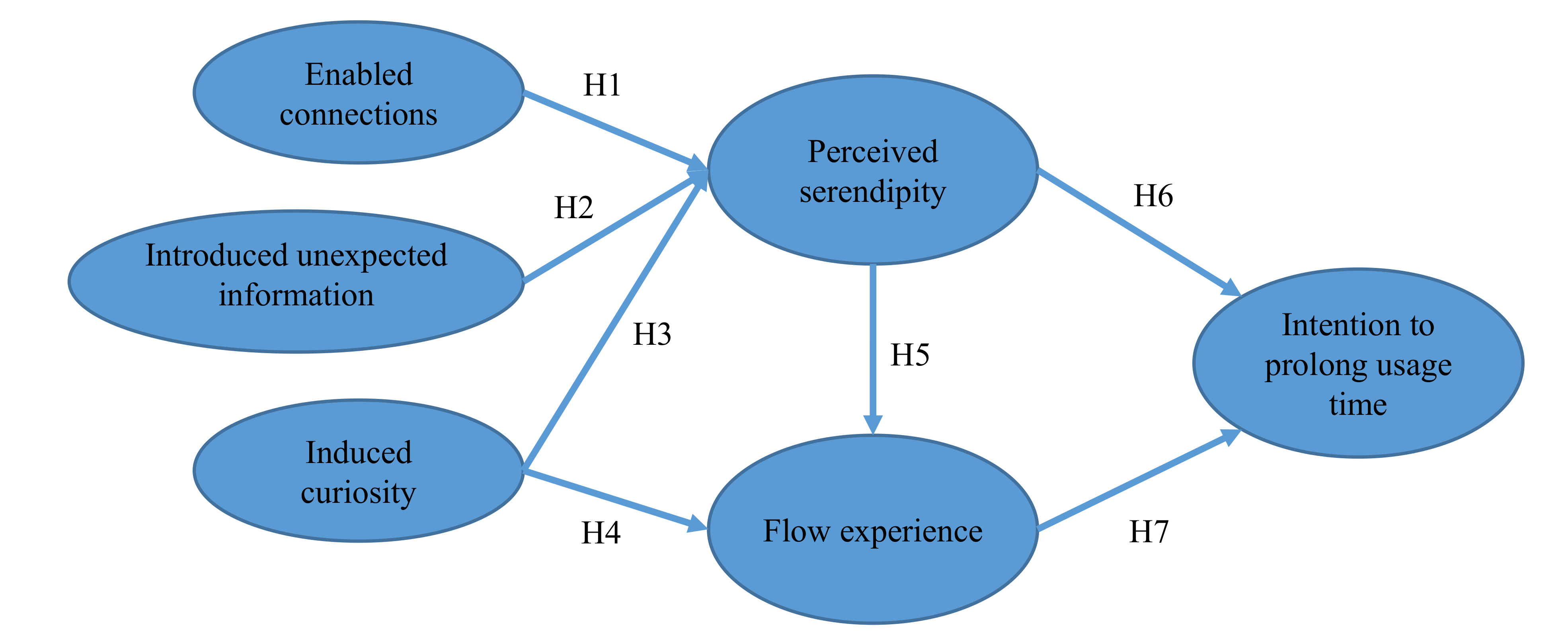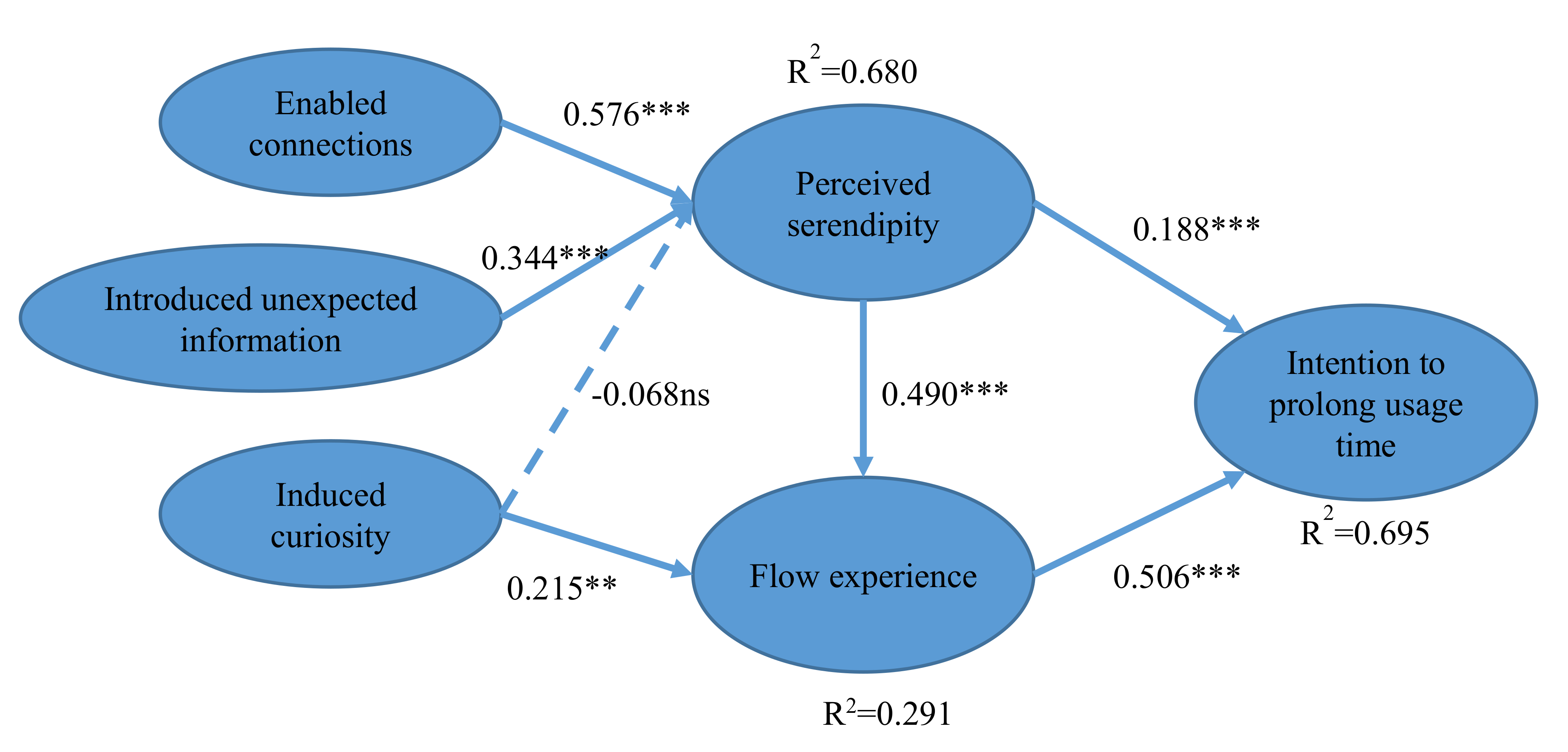Sustainability in Online Video Hosting Services: The Effects of Serendipity and Flow Experience on Prolonged Usage Time
Abstract
1. Introduction
2. Theoretical Background
2.1. Serendipity
2.2. The Flow Experience
3. Conceptual Model and Hypotheses
3.1. Online Video Platform (Online Video Hosting Service)
3.2. The Antecedents of Perceived Serendipity
3.3. Perceived Serendipity, Flow Experience, and Prolonged Usage Time
4. Materials and Methods
4.1. Sample and Data Collection
4.2. Questionnaire Design
4.3. Descriptive Statistics
5. Results
5.1. Tests of the Measurement Model
5.2. Results of Hypothesis Tests
6. Conclusions and Implications
6.1. Theoretical Implications
6.2. Managerial Implications
6.3. Limitations and Future Research
Author Contributions
Funding
Conflicts of Interest
Appendix A. Questionnaire
References
- Lanham, R.A. The Economics of Attention: Style and Substance in the Age of Information; University of Chicago Press: Chicago, IL, USA, 2006. [Google Scholar]
- Chiang, H.-S.; Hsiao, K.-L. YouTube stickiness: The needs, personal, and environmental perspective. Internet Res. 2015, 25, 85–106. [Google Scholar] [CrossRef]
- Zhao, W.; Wang, A.; Chen, Y. How to Maintain the Sustainable Development of a Business Platform: A Case Study of Pinduoduo Social Commerce Platform in China. Sustainability 2019, 11, 6337. [Google Scholar] [CrossRef]
- Grange, C.; Benbasat, I.; Burton-Jones, A. With a Little Help from My Friends: Cultivating Serendipity in Online Shopping Environments. Inf. Manag. 2019, 56, 225–235. [Google Scholar] [CrossRef]
- Iansiti, M.; Levien, R. Keystones and Dominators: Framing Operating and Technology Strategy in a Business Ecosystem; Harvard Business School: Boston, MA, USA, 2004; pp. 24–25. [Google Scholar]
- Agarwal, N.K. Towards a definition of serendipity in information behaviour. Inf. Res. 2015, 20, 675. Available online: http://InformationR.net/ir/20-3/paper675.html (accessed on 5 December 2019).
- Csikszentmihalyi, M. Flow and the Foundations of Positive Psychology; Springer Netherlands: Dordrecht, The Netherlands, 2014. [Google Scholar]
- Hoffman, D.L.; Novak, T.P. Marketing in Hypermedia Computer-Mediated Environments: Conceptual Foundations. J. Mark. 1996, 60, 50. [Google Scholar] [CrossRef]
- Novak, T.P.; Hoffman, D.L.; Yung, Y.-F. Measuring the Customer Experience in Online Environments: A Structural Modeling Approach. Mark. Sci. 2000, 19, 22–42. [Google Scholar] [CrossRef]
- Hsu, C.L.; Lu, H.P. Why Do People Play On-Line Games? An Extended TAM with Social Influences and Flow Experience. Inf. Manag. 2004, 41, 853–868. [Google Scholar] [CrossRef]
- Zhou, T.; Li, H.; Liu, Y. The Effect of Flow Experience on Mobile SNS Users’ Loyalty. Ind. Mngmnt Data Syst. 2010, 110, 930–946. [Google Scholar] [CrossRef]
- Chang, Y.P.; Zhu, D.H. The role of perceived social capital and flow experience in building users’ continuance intention to social networking sites in China. Comput. Hum. Behav. 2012, 28, 995–1001. [Google Scholar] [CrossRef]
- Novak, T.P.; Hoffman, D.L.; Duhachek, A. The influence of goal-directed and experiential activities on online flow experiences. J. Consum. Psychol. 2003, 13, 3–16. [Google Scholar] [CrossRef]
- Skadberg, Y.X.; Kimmel, J.R. Visitors’ flow experience while browsing a Web site: Its measurement, contributing factors and consequences. Comput. Hum. Behav. 2004, 20, 403–422. [Google Scholar] [CrossRef]
- Pelet, J.-É.; Ettis, S.; Cowart, K. Optimal experience of flow enhanced by telepresence: Evidence from social media use. Inf. Manag. 2017, 54, 115–128. [Google Scholar] [CrossRef]
- Foster, A.; Ford, N. Serendipity and information seeking: An empirical study. J. Doc. 2003, 59, 321–340. [Google Scholar] [CrossRef]
- Rice, R.E.; McCreadie, M.; Chang, S.J.L. Accessing and Browsing Information and Communication; MIT Press: Cambridge, MA, USA, 2001. [Google Scholar]
- Erdelez, S.; Heinström, J.; Makri, S.; Björneborn, L.; Beheshti, J.; Toms, E.; Agarwal, N.K. Research perspectives on serendipity and information encountering. Proc. Assoc. Inf. Sci. Technol. 2016, 53, 1–5. [Google Scholar] [CrossRef]
- Makri, S.; Blandford, A.; Woods, M.; Sharples, S.; Maxwell, D. “Making my own luck”: Serendipity strategies and how to support them in digital information environments. J. Assoc. Inf. Sci. Technol. 2014, 65, 2179–2194. [Google Scholar] [CrossRef]
- Roberts, R.M. Serendipity: Accidental Discoveries in Science; Wiley: New York, NY, USA, 1989. [Google Scholar]
- Andre, M.; Schraefel, M.; Teevan, J.; Dumais, S. Designing for (un) serendipity. In Proceedings of the 7th ACM Creativity and Cognition Conference, Berkeley, CA, USA, 26–30 October 2009. [Google Scholar]
- Yi, C.; Jiang, Z.; Benbasat, I. Designing for Diagnosticity and Serendipity: An Investigation of Social Product-Search Mechanisms. Inf. Syst. Res. 2017, 28, 413–429. [Google Scholar] [CrossRef]
- Erdelez, S. Information encountering: A conceptual framework for accidental information discovery. In Proceedings of an International Conference on Information Seeking in Context; Taylor Graham Publishing: London, UK, 1997; pp. 412–421. [Google Scholar]
- Edward Foster, A.; Ellis, D. Serendipity and its study. J. Doc. 2014, 70, 1015–1038. [Google Scholar] [CrossRef]
- Toms, E.G. Understanding and facilitating the browsing of electronic text. Int. J. Hum. Comput. Stud. 2000, 52, 423–452. [Google Scholar] [CrossRef]
- Erdelez, S. Investigation of information encountering in the controlled research environment. Inf. Process. Manag. 2004, 40, 1013–1025. [Google Scholar] [CrossRef]
- Toms, E.G.; McCay-Peet, L. Chance encounters in the digital library. In International Conference on Theory and Practice of Digital Libraries; Springer: Berlin/Heidelberg, Germany, 2009; pp. 192–202. [Google Scholar]
- McCay-Peet, L.; Toms, E. Measuring the dimensions of serendipity in digital environments. Inf. Res. Int. Electron. J. 2011, 16, n3. [Google Scholar]
- Makri, S.; Blandford, A. Coming across information serendipitously—Part 1: A process model. J. Doc. 2012, 68, 684–705. [Google Scholar] [CrossRef]
- Cunha, M.P.; Clegg, S.R.; Mendonça, S. On serendipity and organizing. Eur. Manag. J. 2010, 28, 319–330. [Google Scholar] [CrossRef]
- Erdelez, S. Information Encountering: An Exploration Beyond Information Seeking. Unpublished. Ph.D. Thesis, Syracuse University, Syracuse, NY, USA, 1995. [Google Scholar]
- Lee, C.H.; Chiang, H.S.; Hsiao, K.L. What drives stickiness in location-based AR games? An examination of flow and satisfaction. Telemat. Inform. 2018, 35, 1958–1970. [Google Scholar] [CrossRef]
- Csikszentmihalyi, M. Beyond Boredom and Anxiety; Jossey-Bass: San Francisco, CA, USA, 1975. [Google Scholar]
- Huang, M.-H. Designing website attributes to induce experiential encounters. Comput. Hum. Behav. 2003, 19, 425–442. [Google Scholar] [CrossRef]
- Agarwal, R.; Karahanna, E. Time flies when you’re having fun: Cognitive absorption and beliefs about information technology usage. Mis Q. 2000, 24, 665–694. [Google Scholar] [CrossRef]
- Deng, L.; Turner, D.E.; Gehling, R.; Prince, B. User experience, satisfaction, and continual usage intention of IT. Eur. J. Inf. Syst. 2010, 19, 60–75. [Google Scholar] [CrossRef]
- Luna, D.; Peracchio, L.A.; de Juan, M.D. Cross-Cultural and Cognitive Aspects of Web Site Navigation. J. Acad. Mark. Sci. 2002, 30, 397–410. [Google Scholar] [CrossRef]
- Siekpe, J.S. An examination of the multidimensionality of flow construct in a computer-mediated environment. J. Electron. Commer. Res. 2005, 6, 31. [Google Scholar]
- Hausman, A.V.; Siekpe, J.S. The effect of web interface features on consumer online purchase intentions. J. Bus. Res. 2009, 62, 5–13. [Google Scholar] [CrossRef]
- Jiang, Z.; Benbasat, I. Virtual Product Experience: Effects of Visual and Functional Control of Products on Perceived Diagnosticity and Flow in Electronic Shopping. J. Manag. Inf. Syst. 2004, 21, 111–147. [Google Scholar] [CrossRef]
- Hoffman, D.L.; Novak, T.P. Flow Online: Lessons Learned and Future Prospects. J. Interact. Mark. 2009, 23, 23–34. [Google Scholar] [CrossRef]
- Björneborn, L. Serendipity dimensions and users’ information behaviour in the physical library interface. Inf. Res. 2008, 13, 13–14. [Google Scholar]
- Foster, A.E. A Nonlinear Model of Information Seeking Behaviour. J. Am. Soc. Inf. Sci. Technol. 2004, 55, 228–237. [Google Scholar] [CrossRef]
- Erdelez, S. Information Encountering. In Theories of Information Behaviour; Fisher, K.E., Erdelez, S., McKechnie, L.E.F., Eds.; Information Today Inc.: Medford, NJ, USA, 2005; pp. 179–184. [Google Scholar]
- McCay-Peet, L.; Toms, E.G. Investigating serendipity: How it unfolds and what may influence it. J. Assoc. Inf. Sci. Technol. 2015, 66, 1463–1476. [Google Scholar] [CrossRef]
- Ozkara, B.Y.; Ozmen, M.; Kim, J.W. Examining the effect of flow experience on online purchase: A novel approach to the flow theory based on hedonic and utilitarian value. J. Retail. Consum. Serv. 2017, 37, 119–131. [Google Scholar] [CrossRef]
- Hair, J.F.; Anderson, R.E.; Tatham, R.L.; Black, W.C. Multivariate Data Analysis; Prentice Hall: London, UK, 1998. [Google Scholar]
- Nunnally, J.C. Psychometric Theory, 2nd ed.; McGraw-Hill: New York, NY, USA, 1978. [Google Scholar]
- Fornell, C.; Larcker, D.F. Structural equation models with unobservable variables and measurement error: Algebra and statistics. J. Mark. Res. 1981, 18, 382–388. [Google Scholar] [CrossRef]
- Bagozzi, R.P.; Yi, Y. On the evaluation of structural equation models. J. Acad. Mark. Sci. 1988, 16, 74–94. [Google Scholar] [CrossRef]
- Rettie, R. An exploration of flow during Internet use. Internet Res. 2001, 11, 103–113. [Google Scholar] [CrossRef]
- Akram, U.; Hui, P.; Khan, M.; Yan, C.; Akram, Z. Factors Affecting Online Impulse Buying: Evidence from Chinese Social Commerce Environment. Sustainability 2018, 10, 352. [Google Scholar] [CrossRef]



| Variable | Operational Definition | Reference |
|---|---|---|
| Enabled connections (EC) | YouTube provides connections between topics and allows users to explore or browse across topics. | McCay-Peet and Toms [28] |
| Introduced unexpected information (IU) | YouTube allows users to encounter unexpected topics or provides content that users do not normally explore. | McCay-Peet and Toms [28] |
| Induced curiosity (IC) | The topics or contents on YouTube trigger the curiosity of users for deeper exploration. | McCay-Peet and Toms [28] |
| Perceived serendipity (PS) | A personally surprising accidental finding of useful or interesting information while browsing YouTube | Erdelez [31]; McCay-Peet and Toms [45] |
| Flow experience (FE) | Immersion in browsing activity on YouTube with a sense of time distortion, curiosity, concentration, and enjoyment | Hoffman and Novak [8]; Csikszentmihalyi [7] |
| Intention to prolonged usage time (PUT) | Intention to continue using YouTube | Luna, Peracchio, and de Juan [37] |
| Variable | Value | Frequency (n) | Percentage (%) |
|---|---|---|---|
| Gender | Male | 148 | 36.54 |
| Female | 257 | 63.46 | |
| Age (in years) | <20 | 80 | 19.75 |
| 21–30 | 325 | 80.25 | |
| YouTube usage experience (in years) | <0.5 | 10 | 2.47 |
| 0.5–1.0 | 11 | 2.72 | |
| 1.0–2.0 | 26 | 6.42 | |
| 2.0–3.0 | 49 | 12.10 | |
| >3.0 | 309 | 76.30 | |
| YouTube usage frequency | Daily | 208 | 51.36 |
| Several times per week (but not every day) | 156 | 38.52 | |
| Once per week | 21 | 5.19 | |
| 2–3 times per month | 13 | 3.21 | |
| Less than once per month | 7 | 1.73 | |
| Average usage time on YouTube (hours) | <0.5 | 62 | 15.31 |
| 0.5–1.0 | 169 | 41.73 | |
| 1.0–2.0 | 93 | 22.96 | |
| 2.0–3.0 | 48 | 11.85 | |
| >3.0 | 33 | 8.15 |
| Fit Indices | Recommended Standard | Measurement Model |
|---|---|---|
| χ2/df | ≤3 | 2.513 |
| Goodness of fit index (GFI) | ≥0.9 | 0.898 |
| Adjusted for degrees of freedom (AGFI) | ≥0.8 | 0.866 |
| Normed fit index (NFI) | ≥0.9 | 0.907 |
| Non-normed fit index (NNFI) | ≥0.9 | 0.927 |
| Comparative fit index (CFI) | ≥0.9 | 0.938 |
| Root mean square error of approximation (RMSEA) | ≤0.08 | 0.065 |
| Standard root mean square residual (SRMR) | ≤0.08 | 0.0553 |
| Construct | Item | Factor Loading | Cronbach’s Alpha (α) | Composite Reliability | Average Variance Extracted |
|---|---|---|---|---|---|
| Induced curiosity (IC) | IC01 | 0.804 | 0.785 | 0.784 | 0.644 |
| IC02 | 0.801 | ||||
| Introduced unexpected information (IU) | IU01 | 0.689 | 0.703 | 0.711 | 0.553 |
| IU02 | 0.794 | ||||
| Enabled connections (EC) | EC01 | 0.749 | 0.821 | 0.822 | 0.536 |
| EC02 | 0.732 | ||||
| EC03 | 0.746 | ||||
| EC04 | 0.699 | ||||
| Perceived serendipity (PS) | SS01 | 0.745 | 0.870 | 0.870 | 0.627 |
| SS02 | 0.774 | ||||
| SS03 | 0.831 | ||||
| SS04 | 0.815 | ||||
| Flow experience (FE) | FE01 | 0.748 | 0.893 | 0.894 | 0.680 |
| FE 02 | 0.870 | ||||
| FE 03 | 0.835 | ||||
| FE 04 | 0.839 | ||||
| Intention to prolong usage time (PUT) | PUT01 | 0.662 | 0.832 | 0.837 | 0.564 |
| PUT02 | 0.831 | ||||
| PUT03 | 0.796 | ||||
| PUT04 | 0.702 |
| Construct | IC | IU | EC | PS | FE | PUT |
|---|---|---|---|---|---|---|
| IC | 0.802 | |||||
| IU | 0.526 ** | 0.743 | ||||
| EC | 0.565 ** | 0.396 ** | 0.732 | |||
| PS | 0.527 ** | 0.528 ** | 0.626 ** | 0.791 | ||
| FE | 0.368 ** | 0.346 ** | 0.456 ** | 0.463 ** | 0.824 | |
| PUT | 0.408 ** | 0.424 ** | 0.378 ** | 0.503 ** | 0.704 ** | 0.751 |
| Hypotheses | β | Result |
|---|---|---|
| H1: Enabled connections positively relates to perceived serendipity while browsing on YouTube. | 0.576 *** | Supported |
| H2: Introduced unexpected information positively relates to perceived serendipity while browsing on YouTube. | 0.344 *** | Supported |
| H3: Induced curiosity positively relates to perceived serendipity while browsing on YouTube. | −0.068 ns | Not supported |
| H4: Induced curiosity positively relates to flow experience while browsing on YouTube. | 0.215 ** | Supported |
| H5: Perceived serendipity positively relates to experiencing the flow experience while browsing on YouTube. | 0.490 *** | Supported |
| H6: Perceived serendipity positively relates to intention to prolong usage time while browsing on YouTube. | 0.188 *** | Supported |
| H7: The flow experience positively relates to intention to prolong usage time while browsing on YouTube. | 0.506 *** | Supported |
| Construct | PS | FE | PUT | ||||
|---|---|---|---|---|---|---|---|
| Direct | Indirect | Direct | Indirect | Direct | Indirect | Total | |
| EC | 0.576 | -- | -- | 0.282 | -- | 0.251 | 0.251 |
| IU | 0.344 | -- | -- | -- | 0.150 | 0.150 | |
| IC | -- | -- | 0.215 | -- | -- | 0.109 | 0.109 |
| PS | -- | -- | -- | 0.490 | 0.188 | 0.248 | 0.436 |
| FE | -- | -- | -- | -- | 0.506 | -- | 0.431 |
| R2 | 0.680 | 0.291 | 0.695 | ||||
| Hypothesis | Entire Sample | Gender | Usage Frequency | ||||
|---|---|---|---|---|---|---|---|
| Male | Female | Daily | Non-Daily | ||||
| β | β | β | z-Score | β | β | z-Score | |
| H1: EC→PS | 0.576 *** | 0.399 ** | 0.679 *** | 1.547 | 0.593 *** | 0.482 *** | −0.609 |
| H2: IU→PS | 0.344 *** | 0.348 ** | 0.355 *** | −0.084 | 0.532 *** | 0.196 ** | −2.217 * |
| H3: IC→PS | −0.068 | 0.040 | −0.093 | −0.717 | −0.150 | 0.001 | 0.812 |
| H4: IC→FE | 0.215 ** | 0.244 | 0.200 * | −0.279 | 0.420 *** | 0.046 | −2.395 * |
| H5: PS→FE | 0.490 *** | 0.664 *** | 0.366 ** | −1.541 | 0.268 * | 0.696 *** | 2.104 * |
| H6: PS→PUT | 0.118 *** | 0.217 ** | 0.161 ** | −0.569 | 0.150 ** | 0.264 *** | 1.202 |
| H7: FE→PUT | 0.506 *** | 0.527 *** | 0.488 *** | −0.397 | 0.581 *** | 0.417 *** | −1.788 |
| R2: PS | 0.680 | 0.622 | 0.716 | 0.776 | 0.568 | ||
| R2: FE | 0.291 | 0.483 | 0.190 | 0.367 | 0.224 | ||
| R2: PUT | 0.695 | 0.769 | 0.640 | 0.741 | 0.661 | ||
© 2020 by the authors. Licensee MDPI, Basel, Switzerland. This article is an open access article distributed under the terms and conditions of the Creative Commons Attribution (CC BY) license (http://creativecommons.org/licenses/by/4.0/).
Share and Cite
Lu, H.-P.; Cheng, Y.-H. Sustainability in Online Video Hosting Services: The Effects of Serendipity and Flow Experience on Prolonged Usage Time. Sustainability 2020, 12, 1271. https://doi.org/10.3390/su12031271
Lu H-P, Cheng Y-H. Sustainability in Online Video Hosting Services: The Effects of Serendipity and Flow Experience on Prolonged Usage Time. Sustainability. 2020; 12(3):1271. https://doi.org/10.3390/su12031271
Chicago/Turabian StyleLu, Hsi-Peng, and Yi-Hsiu Cheng. 2020. "Sustainability in Online Video Hosting Services: The Effects of Serendipity and Flow Experience on Prolonged Usage Time" Sustainability 12, no. 3: 1271. https://doi.org/10.3390/su12031271
APA StyleLu, H.-P., & Cheng, Y.-H. (2020). Sustainability in Online Video Hosting Services: The Effects of Serendipity and Flow Experience on Prolonged Usage Time. Sustainability, 12(3), 1271. https://doi.org/10.3390/su12031271





